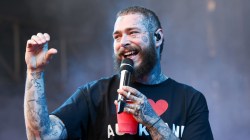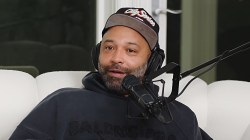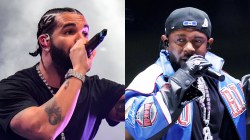As Hip Hop celebrated the life and legacy of Tupac Shakur twenty years following his untimely death, HipHopDX provided a hefty amount of editorials including one written by contributor Michael Namikas who mentioned Chi Modu’s upcoming coffee table photobook Uncategorized: Tupac Shakur. Set for release at the top of November, the book features intimate unreleased photographs of Pac and provides another classic angle to the New York-native’s stunning catalog of pictures.
Between shooting over 30 cover photos for The Source, numerous cover art from legends like Mobb Deep to Snoop Dogg and tons of other classic shots, Modu has documented the culture like no other. He did it by bringing out the most in his subject’s humanity. Taking time to talk over the phone as he prepared to release the next phase in his Uncategorized series, he talks the beauty and danger in capturing Hip Hop’s most larger-than-life figures.
“If You Couldn’t Carry Yourself Well, You Might’ve Gotten Rolled Up On While On Location”
HipHopDX: You’ve been doing this since the early 90s and over twenty years ago, Hip Hop wasn’t nearly as mainstream as it was now.

AD LOADING...
Chi Modu: I will say that it wasn’t really mainstream. When I was doing it, Hip Hop was still an outsider. The good part about it was that we were a community of outsiders, but we were having fun while we were changing the world. We weren’t welcomed. So, we stuck to our own lane. That’s what Hip Hop did and that was create its own lane. That’s why I see the difference from what I did to the later years. In the later years, it became a genre full of all the supported staff, label people and stylists which is what happens to genres when they get big. When I did it, photographers needed their own street credibility. If you couldn’t carry yourself well, you might’ve gotten rolled up on while on location. You had to know how to move. It wasn’t no ‘I came with the label.’ You had to establish your own relationships.
DX: Many considering 90s Hip Hop to be the Wild Wild West in regards to how unhinged rappers could be. There were plenty of stories of rap journalists getting run-up on. Did you ever experience any dangerous moments yourself?
Chi Modu: Plenty, but one thing that you’ll learn about me pretty quickly is that I’m a cool customer. When it’s hot, I get even cooler. That’s sort of why I have a handle in this space and not everyone has the temperament to handle it. I remember once I was in a convertible heading over to this photographer’s studio in South Central if I remember correctly. It was Snoop in the front car along with the guy from Cross Colours [clothing line], I was in the middle car with two of my assistants and in the car behind us was Dr. Dre and D.O.C. We stopped at a light and a kid on the side of a corner had a bandana on his face and reached for a gun. He saw Snoop, who at that time, was a heavy duty Crip. Snoop always carried two .38s on him which you can see in one of the photos I took of him. He leans back at the kid like “what’s up?” The kid looks back at him, puts the bandana down, puts the gun down and says “go ahead.” I remember that like it was yesterday. When we got to the studio, everyone was on energy afterwards with people telling the story. Snoop said he looked on the other side of the street and saw his boys back away so it wasn’t going to be a shootout because he knew we were outgunned so it worked perfectly.
DX: You mentioned that photo where Snoop is aiming the gun at the camera and something tells me it was loaded. How did you even handle photos like those?

AD LOADING...
Chi Modu: I definitely have a rule with that. If a gun is pointing in my direction, which I prefer it not [to be], after you clear it, pass it to me and I’ll clear it and then we can proceed. It’s a lot at stake there. I prefer not to have them on my set, but sometimes, it’s a part of the life of that person. Those guns could end a life and they needed to be around because the streets were hot.
Chi Modu Recounts Helping Shape 2Pac’s Image On Camera
DX: You were shooting Pac and Biggie as they were beefing and the media was hyping the East Coast vs. West Coast beef.
Chi Modu: I never was into the whole East Coast/West Coast beef. It was being hyped up and turning into a life of its own, but I never really bought into it. I’m someone who is from The East, but I shot Snoop’s first album cover. When Pac saw me, he gave me a hug. Biggie was my boy. How did I move that way? I never bought into that because real recognize real and beefs aren’t coast-to-coast, they’re individual. The fact that they tried to make it coastal was ridiculous. I had to go into video shoots, recording studios and even grandmother’s houses on both coasts. I can’t deal with border wars so I had to get the photographs. I never dealt with any of that.

AD LOADING...
DX: You’re set to release your photo book featuring unreleased Pac shots through Tupac Shakur: Uncategorized November 1st. This week was the 20th anniversary of his death and Pac’s popularity remains at an all time high. What’s the goal with this photo book?
Chi Modu:Uncategorized is my brand. So I roll out some of my productions whether it be billboards around New York City that I did in 2014 and 2015, work in Finland and the first Uncategorized book I came out with last year. There’s never been a photo book of Tupac. In some way, no one has done a book on him like this and included my photographs. Like all these other iconic people in other genres let it be Elvis, Jim Morrison and James Dean. What makes this project unique is that I’m the only photographer to have a whole book on him because I had a variety of experiences on him. It’s broken down into four sections with Atlanta, Stone Mountain, Georgia, Los Angeles and Los Angeles with The Outlaws. That breaks down the four different settings that I was with Pac. The idea was to show my own retrospective of Tupac through my photographs in a well-made coffee table book. I traveled the entire globe and there isn’t a single corner where they don’t know Tupac from Indonesia to Syria. That says a lot about his power and reach. I was blessed to have so many intimate photographs with him. Together with Pac, we helped shape his image with my camera. He did it by just being Tupac.
DX: Pac was viewed in so many ways by so many people. How exactly did you accumulate through photography?
Chi Modu: For me, my plan when I photograph a rapper, especially one like Pac, is to show them as human beings and maintain their strength, but letting some vulnerability come through. When you take that approach, he looks like a strong black man which as a black man myself, I appreciate that. On the other side, he looks like someone’s son, friend or someone you know. That’s the full gamut of a human being. That’s what I do in my photography. Not so much bravado, but who you are as a person. The first time we shot the photos, me and Pac became friends. He was the only one I sent home because my equipment didn’t work so he came back the next day. After we did the famous picture of him tying his bandana and all that stuff, he ask me to hang out with him. I took a writer and art director with me and we all just hung out. After we parted ways, I don’t even know how that night ended to be honest.

AD LOADING...
DX: Sounds fun.
Chi Modu: We were actually hanging out at his house chilling. We parted ways and a few things happened in between. I met up with him again at The Palladium after I shot the stuff in Atlanta and the club in New York. After that, he went to jail in New York and he was on Death Row. I caught up with him again and that’s when we did the L.A. sessions. He did some push-ups and got ready. You can see in that session how comfortable we are together. When you see the blue sky, Pac and The Outlaws there, you have to remember there’s a camera there. It just looks like they’re living their life. The point is that I became one of them and my camera being present didn’t change anything. That’s when you’re able to get the more personal and human shots. Everybody was released. I was shooting and drinking beer.
Chi Modu Details His Favorite Cover Shots For The Source
DX: Funny you say that because there aren’t too many photographers who were able to say they had to wake up The Notorious B.I.G. out of bed to shoot the iconic Twin Towers photo.

AD LOADING...
Chi Modu: Nah, because it’s a different time. When you think back to it, Biggie came up through The Unsigned Hype at The Source so Biggie was my man. He was one of my dudes so I knew him before he was signed. In a way, that was really natural to go in his bedroom and wake him up. Flash forward now, he’s a global star. You say that and it blows people away. That was really normal because that was my boy and we got along. It’s weird because now these people are legendary. Even when people call me a legend, it almost makes me chuckle. We were really just doing our work and enjoying it. One thing I do take credit for is taking the visuals of the movement very seriously. As you see from my archive, I thoroughly covered it as much as possible. That’s why a lot of it lives to this day because I understood the importance of that.
DX: Was there an artist you shot that where the idea of them becoming a great never crossed your mind?
Chi Modu: Not really because you can always kind-of tell when people have it. I’ll tell you one thing with Big L, who was here for a brief time. Big L’s legacy is very powerful and I can only imagine where he could have gone. He’s not someone who I actually photographed. I’m just speaking from a Hip Hop perspective of when you see that thing. When you feel that bug, energy and feel of that artist, you just know. You can’t really describe it, but it’s really familiar to me. I’ve seen it before. I think in a way, that’s why I’m able to photograph it because I understand what that means. It’s really like a God-given ability. You can be a good lyricist or producer, but not everyone has that thing.
DX: Surely many have spoken on how digital media has changed things for writers, but what did that do for photographers in your opinion?

AD LOADING...
Chi Modu: I’m very comfortable with film, but digital gives me some convenience. Film gives me a quality and permanence that digital can not. So, it’s a balance. I’m extremely happy with the work I did on film because there was a real tangible product to it. Digital files are tangible products, but I can scan those negatives and slides and it looks like I did it today. There’s no fall off. Digital holds up, but it’s not as dense as film. The convenience of digital is off the charts like an advantage. I was with a magazine so I could pass off the cost, but trying to process 25 rolls of film is a lot.
DX: You’ve shot over 30 covers for The Source. Out of all of them, which one was the most rewarding one to shoot?
Chi Modu: When I first started doing The Source covers, there was a bit of experimentation. They didn’t really know what they were doing and I was still trying to figure it out. When covers started to ramp up, the more leeway and freedom the art department allowed. I started playing around with cross processing in saturating the colors. I was shooting an LL Cool J cover in I believe 1993, maybe. The following cover was the Onyx [June 1993]. Those two ramped it up and then the quality jumped from there. That’s when it started transitioning. At that point, I was really trying to make high-end quality photos for the subject matter. And sometimes, I got it wrong because experimentation can lead to that sometimes. That’s the nature of it.
DX: Finally, one of my favorite photos is the one you did of The Geto Boys in Houston. Being a guy from New York shooting Hip Hop’s Golden Era, what was it like shooting early Southern rap?

AD LOADING...
Chi Modu: First off, The Geto Boys were my guys, especially Scarface. I always got along with Scarface. They were crazy as all hell, but I liked them. I’ve always been at home around that camp. They always treated me like family. I’ve been on Scarface’s boat with his mother. It’s that kind of relationship. Furthermore, to even go there, they run Houston. They may even run it till this day. It’s funny to move around with the kings of the city because you move on higher ground. I remember riding around the 610 Loop with Scarface in his Benz that he cut the roof off of. It was a homemade convertible and he had a little built-in TV monitor which could be considered the original flat-screen. We’re riding down the freeway and he just turns up Metallica. He’s just headbanging as we drive around the 610 Loop. I think I have some shots of that somewhere. It’s only when I tell these stories that I realize how crazy they sound to people when they hear it. We’re riding around blasting Metallica and Scarface is a hardcore Hip Hop head.



